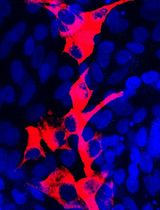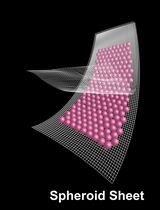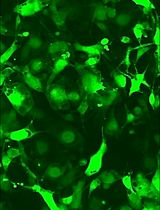- EN - English
- CN - 中文
Microvesicle Isolation from Rat Brain Extract Treated Human Mesenchymal Stem Cells
从大鼠脑提取物处理的人间充质干细胞中分离微泡
发布: 2017年07月05日第7卷第13期 DOI: 10.21769/BioProtoc.2375 浏览次数: 11634
评审: Xi FengAnonymous reviewer(s)
Abstract
Microvesicle (MVs) are submicron-sized membranous vesicles that are either actively released from cells via secretory compartments or shed from cell surface membranes. MVs are generated by many cell types and serve as vehicles that transfer biological information (e.g., protein, mRNA, and miRNA) to distant cells, thereby affecting their gene expression, proliferation, differentiation, and function. Although their physiological functions are not clearly defined, recent studies have shown their therapeutic potential for tissue repair and regeneration. While MVs can be isolated readily from mesenchymal stem cells (MSCs) and other cell types from various sources, the yield of MVs under conventional culture condition in vitro is one of the limiting factors for both the in vivo functional study as well as in vitro molecular analysis. Here, we provide a protocol to increase the yield of microvesicles by preconditioning MSCs with rat brain extract.
Keywords: Mesenchymal stem cell (间充质干细胞)Background
Generation of neural stem cells or neural cells by direct reprogramming or utilization of mesenchymal stem cells for cell replacement therapy is potential options for neurodegenerative diseases (Adib et al., 2015). Recent studies have demonstrated that microvesicles derived from MSCs represent a novel and safe alternative to other cell replacement approaches to enhance tissue regeneration such as neuronal regeneration, immune modulation, angiogenesis in brain injury (Kim et al., 2013; Porro et al., 2015; Lee et al., 2016). Little is known about how external signals derived from damaged tissues can affect the quantity and composition of microvesicles. The contents and quantities of such functional secretome of MSCs can be significantly changed in response to their microenvironment (Qu et al., 2007). For example, ischemic brain extracts or hypoxia are known to induce the synthesis of a number of cytokines and growth factors that are beneficial to the tissue regeneration process (Chen et al., 2007; Shin et al., 2014). In the present study, normal and ischemic brain extracts as a form of brain injury signal were employed to increase the yields as well as to modulate the molecular composition of MVs from MSCs that can be beneficial for their clinical application. Indeed, the quantity of MVs in conditioned medium of MSCs was greatly increased by the treatment of normal brain extracts or ischemic brain extracts. The current protocol was mainly based on previously described methods (Choi et al., 2007; Kim et al., 2012) with a few modifications including reagents, recipes. The yield and composition of microvesicles can be significantly modulated by preconditioning of producing cells by physical, chemical or biological means. As an example, we utilized brain extract to stimulate MSCs to simulate signal for brain tissue damage and the final products (MVs) can be a potent specific therapy for brain tissue repair and regeneration. This protocol may provide a clue to develop better strategies to obtain higher yields of MVs with stronger therapeutic potential from various cell sources.
Materials and Reagents
- 4-0 surgical suture
- 0.2 µm syringe filters (Sartorius, catalog number: 17823-K )
- 0.45 µm syringe filters (Sartorius, catalog number: 16555-K )
- Falcon tubes 50 ml (Corning, Falcon®, catalog number: 352070 )
- Falcon tubes 15 ml (Corning, Falcon®, catalog number: 352099 )
- T75 culture flasks (SPL LIFE SCIENCES, catalog number: 70075 )
- Polyallomer tube 38 ml (Beckman Coulter, catalog number: 344058 , for gradient formation and fractionation)
- Polyallomer tube 13.2 ml (Beckman Coulter, catalog number: 344059 , for gradient formation and fractionation)
- 8-week-old male Sprague-Dawley rat (Koatech)
- Human adipose tissue-derived MSCs (from 2 healthy female donors, passage 4) provided from Yonsei cell therapy center or adipose derived stem cells purchased from Lonza (Lonza, catalog number: PT-5006 )
- Isoflurane (Hana Pharm, Korea)
- 80% N2O
- 20% O2
- Ketamine
- Xylazine
- Bradford protein assay kit I (Bio-Rad Laboratories, catalog number: 5000001 )
- Dulbecco’s phosphate buffered saline (DPBS) (Biowest, catalog number: L0615-500 )
- Trypsin/EDTA (0.05%, phenol red) (Thermo Fisher Scientific, InvitrogenTM, catalog number: 25300054 )
- Trypan blue solution 0.4% (in normal saline) (Thermo Fisher Scientific, GibcoTM, catalog number: 15250061 )
- DMEM low glucose (GE Healthcare, HycloneTM, catalog number: SH30021.01 )
- Penicillin/streptomycin (5,000 U/ml) (GE Healthcare, HycloneTM, catalog number: SV30010 )
- Fetal bovine serum (FBS) (GE Healthcare, HycloneTM, catalog number: SH30071.03 )
- Sodium chloride (NaCl) (Sigma-Aldrich, catalog number: S9888 )
- HEPES (Thermo Fisher Scientific, GibcoTM, catalog number: 15630080 )
- 10 mM Tris-HCl (WHITLAB, catalog number: BTH-9274 )
- Sucrose (Sigma-Aldrich, catalog number: S9378 )
- EDTA (Bio-Rad Laboratories, catalog number: 1610729 )
- OptiPrepTM (Alere Technologies, Axis-Shield Density Gradient Media, catalog number: 1114542 )
- MSC culture media (see Recipes)
- Sucrose dilution buffer (see Recipes)
- Sucrose cushion (see Recipes)
- OptiPrepTM solution (see Recipes)
Equipment
- Surgical scissors–Straight sharp/blunt 12 cm (Fine Science Tools, catalog number: 14001-12 )
- Narrow pattern forceps–Curved 12 cm, 2 x 1.25 mm (Fine Science Tools, catalog number: 11003-12 )
- Iris scissors–Large loops, angled (Fine Science Tools, catalog number: 14107-09 )
- Scalpel handle with scalpel (Fine Science Tools, catalog numbers: 10011-00 , 10003-12 )
- Bone rongeur (JEUNG DO BIO & PLANT, catalog number: H-2041-1 )
- Adult rat brain matrix (Kent Scientific, catalog number: RBMS-300C )
- Tissue grinders (WHEATON, catalog number: 357546 )
- Pipettes
- 10 ml serological pipettes (SPL LIFE SCIENCES, catalog number: 91010 )
- Ice bucket
- Centrifuge (Eppendorf, model: 5804 )
- Minimate TFF capsule system with a 100 kDa membrane (Pall, catalog number: OA100C12 )
- Glass Pasteur pipettes (Fisher Scientific, catalog number: 13-678-20A )
- 37 °C, 5% CO2 cell culture incubator (Eppendorf, model: Galaxy® 170 S )
- Inverted microscope (Olympus, model: CKX41 )
- Hemocytometer
- Ultracentrifuge (Beckman Coulter, model: OptimaTM XPN-100 )
- Rotor: SW41Ti (Beckman Coulter, catalog number: 331362 )
- Rotor: SW32Ti (Beckman Coulter, catalog number: 369650 )
- Peristaltic pump (Poong Lim Tech, catalog number: PP-150 )
- Masterflex L/S Easy-Load II head for Precision Tubing, PPS/CRS (Cole-Parmer, catalog number: EW-77200-50 )
- Feed reservoir (100 ml or 500 ml)
Procedure
文章信息
版权信息
© 2017 The Authors; exclusive licensee Bio-protocol LLC.
如何引用
Lee, J. Y., Choi, S. and Kim, H. (2017). Microvesicle Isolation from Rat Brain Extract Treated Human Mesenchymal Stem Cells. Bio-protocol 7(13): e2375. DOI: 10.21769/BioProtoc.2375.
分类
干细胞 > 成体干细胞 > 间充质干细胞
细胞生物学 > 细胞分离和培养 > 细胞分化
细胞生物学 > 基于细胞的分析方法 > 转运
您对这篇实验方法有问题吗?
在此处发布您的问题,我们将邀请本文作者来回答。同时,我们会将您的问题发布到Bio-protocol Exchange,以便寻求社区成员的帮助。
Share
Bluesky
X
Copy link












